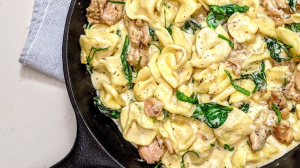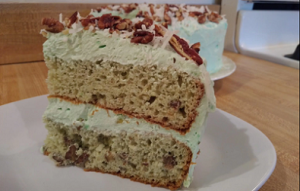Dive into a warm and comforting cheese sauce that elevates any dish, from mac and cheese to nachos. This creamy blend of sharp cheddar and parmesan is irresistibly rich and perfect for a quick and easy homemade treat.
Most of the ingredients for this recipe are common pantry items. However, you may need to look for white pepper and onion powder if they are not staples in your kitchen. Sharp cheddar cheese and parmesan cheese are also essential, so ensure you have these specific types of cheese for the best flavor.
Ingredients For Creamy Cheese Sauce Recipe
Butter: Adds richness and helps create a smooth base for the sauce.
Flour: Thickens the sauce to the perfect consistency.
Milk: Provides the creamy texture and balances the flavors.
Onion powder: Adds a subtle depth of flavor without overpowering the sauce.
White pepper: Lends a mild spiciness that complements the cheese.
Sharp cheddar cheese: The primary cheese, which gives a robust and tangy flavor.
Parmesan cheese: Adds a salty and nutty complexity to the sauce.
One reader, Dorri Fisk says:





This creamy cheese sauce is a game-changer! It’s rich, smooth, and bursting with cheesy goodness. Perfect for dipping or drizzling over veggies. A must-try!
Key Techniques for Mastering Creamy Cheese Sauce
Yes.
How to melt butter: Place the butter in a saucepan over medium heat and allow it to melt completely. How to make a roux: Add flour to the melted butter and cook, stirring constantly, for 1 to 2 minutes until it forms a smooth paste. How to add milk gradually: Pour a small amount of milk into the roux, whisking continuously until smooth before adding more milk in increments. How to whisk: Use a whisk to mix ingredients thoroughly, ensuring there are no lumps. How to cook over medium heat: Maintain a medium heat setting on your stove to avoid burning or undercooking. How to melt cheese in sauce: Remove the saucepan from heat and add the cheeses, stirring until they are fully melted and incorporated into the sauce.
How To Make Creamy Cheese Sauce
Skip the store-bought sauces and whip up your own cheese sauce at home! It’s quick, delectable, and takes only 15 minutes to make.
Serves:
Ingredients
- 2tbspbutter
- 2tbspflour
- 1½cupsmilk
- ¼tsponion powder
- ⅛tspwhite pepper,or a pinch
- 1¼cupsharp cheddar cheese
- ¼cupparmesan cheese
Instructions
-
Melt the butter in a saucepan.
-
Add the flour and cook for 1 to 2 minutes.
-
Add the milk, a small amount at a time, whisking smooth after each addition.
-
Add the onion powder and white pepper.
-
Continue to cook over medium heat, whisking continually until slightly thick.
-
Remove from heat, then add the cheddar cheese and parmesan cheese.
-
Stir until melted.
-
Serve with chips, and enjoy!
Nutrition
- Calories: 651.16kcal
- Fat: 50.25g
- Saturated Fat: 29.75g
- Trans Fat: 1.44g
- Monounsaturated Fat: 12.83g
- Polyunsaturated Fat: 2.11g
- Carbohydrates: 16.79g
- Fiber: 0.30g
- Sugar: 9.67g
- Protein: 33.22g
- Cholesterol: 145.62mg
- Sodium: 867.71mg
- Calcium: 989.88mg
- Potassium: 336.19mg
- Iron: 0.47mg
- Vitamin A: 436.76µg
- Vitamin C: 0.10mg
Expert Tip for Achieving the Ideal Consistency in Cheese Sauce
When adding the milk to the roux (the butter and flour mixture), make sure to do it gradually. This helps prevent lumps and ensures a smooth, creamy sauce. Whisk continuously to incorporate each addition of milk fully before adding more.
Time-Saving Tips for Making Cheese Sauce from Scratch
Pre-measure ingredients: Measure out all ingredients before starting to save time during cooking.
Use pre-shredded cheese: Opt for pre-shredded cheddar cheese and parmesan cheese to cut down on prep time.
Warm the milk: Slightly warm the milk before adding it to the sauce to speed up the thickening process.
Use a non-stick pan: A non-stick saucepan makes cleanup quicker and prevents the sauce from sticking.
Whisk continuously: Whisking continuously prevents lumps and ensures a smooth cheese sauce faster.
Substitute Ingredients For Creamy Cheese Sauce Recipe
butter - Substitute with margarine: Margarine has a similar fat content and can provide a similar texture and flavor.
butter - Substitute with olive oil: Olive oil can be used for a healthier option, though it will slightly alter the flavor.
flour - Substitute with cornstarch: Cornstarch can thicken the sauce similarly to flour but may require a different amount.
flour - Substitute with arrowroot powder: Arrowroot powder is a gluten-free alternative that can also thicken sauces effectively.
milk - Substitute with heavy cream: Heavy cream will make the sauce richer and creamier.
milk - Substitute with unsweetened almond milk: Almond milk is a dairy-free alternative that can be used for those with lactose intolerance.
onion powder - Substitute with garlic powder: Garlic powder can provide a different but complementary flavor to the sauce.
onion powder - Substitute with finely chopped onions: Fresh onions can add a more robust onion flavor and texture.
white pepper - Substitute with black pepper: Black pepper is more common and can be used, though it will add a slightly different flavor and color.
white pepper - Substitute with cayenne pepper: Cayenne pepper can add a bit of heat and a different flavor profile.
sharp cheddar cheese - Substitute with mild cheddar cheese: Mild cheddar can be used for a less intense flavor.
sharp cheddar cheese - Substitute with gruyere cheese: Gruyere can provide a similar creamy texture with a different, nutty flavor.
parmesan cheese - Substitute with pecorino romano: Pecorino Romano has a similar texture and a slightly saltier, tangier flavor.
parmesan cheese - Substitute with asiago cheese: Asiago can provide a similar texture and a slightly different flavor.
How to Beautifully Present Your Homemade Cheese Sauce
Serve in a small, elegant bowl: Use a sleek, white porcelain bowl to highlight the rich, creamy texture of the cheese sauce.
Garnish with fresh herbs: Add a sprinkle of finely chopped chives or parsley on top to add a pop of color and a hint of freshness.
Accompany with gourmet chips: Serve with artisanal potato chips or pita chips, arranged neatly around the bowl for an upscale touch.
Drizzle with truffle oil: Add a light drizzle of truffle oil over the cheese sauce to elevate the flavor profile and add a luxurious aroma.
Use a decorative plate: Place the bowl on a large, decorative plate with a contrasting color to make the presentation visually appealing.
Add a touch of spice: Sprinkle a tiny pinch of paprika or cayenne pepper on top for a subtle kick and a vibrant red accent.
Serve with a tasting spoon: Include a small, elegant tasting spoon to enhance the dining experience and make it easier to enjoy the cheese sauce.
Create a cheese pull effect: Ensure the cheese sauce is warm enough to create a delightful cheese pull when dipping the chips, adding an interactive and satisfying element to the dish.
Essential Kitchen Tools for Making the Perfect Cheese Sauce
Saucepan: A medium-sized saucepan is essential for melting the butter, cooking the flour, and combining all the ingredients smoothly.
Whisk: A whisk is crucial for ensuring the sauce remains lump-free when adding the milk and for stirring in the cheeses.
Measuring spoons: Use measuring spoons to accurately measure the butter, flour, onion powder, and white pepper.
Measuring cups: Measuring cups are needed to measure the milk and cheeses precisely.
Grater: A grater is useful if you're using block cheese and need to grate the cheddar and parmesan.
Spatula: A spatula can help in scraping down the sides of the saucepan and ensuring all the cheese is melted and incorporated.
Serving bowl: Once the sauce is ready, transfer it to a serving bowl for easy dipping with chips.
Proper Storage and Freezing Methods for Creamy Cheese Sauce
- Allow the cheese sauce to cool completely before storing or freezing.
- For storing in the refrigerator, transfer the cooled sauce to an airtight container. It will keep well for up to 5 days in the fridge.
- If you plan to freeze the sauce, follow these steps:
- Portion the cooled sauce into freezer-safe containers or resealable bags, leaving some headspace for expansion during freezing.
- Label the containers or bags with the date and amount of sauce.
- Place the containers or bags in the freezer, laying them flat for easier storage.
- Frozen cheese sauce will maintain its best quality for up to 2 months.
- To thaw frozen cheese sauce, transfer it from the freezer to the refrigerator and allow it to thaw overnight.
- Reheat the thawed sauce gently in a saucepan over low heat, whisking constantly to prevent separation and ensure a smooth consistency. If the sauce appears too thick, you can add a splash of milk to thin it out.
- Note: While freezing cheese sauce is possible, it may slightly affect the texture and consistency upon thawing and reheating. The sauce may appear slightly grainy or separated, but whisking it well during reheating will help restore its creamy texture.
How To Reheat Leftover Creamy Cheese Sauce
Reheat the cheese sauce in a saucepan over low heat, stirring constantly to prevent burning or sticking to the bottom of the pan. This method ensures even heating and helps maintain the smooth, creamy texture of the sauce.
If the sauce has thickened during storage, gradually whisk in small amounts of milk or cream to thin it out and restore its original consistency. Be careful not to add too much liquid at once, as this may cause the sauce to become too thin.
For a quicker reheating method, transfer the cheese sauce to a microwave-safe bowl and heat it in 30-second intervals, stirring well between each interval. This approach allows you to monitor the consistency and temperature of the sauce more closely, preventing overheating or separation.
To add a fresh flavor and aroma to the reheated sauce, consider stirring in a pinch of herbs like thyme, parsley, or chives. This can help enliven the taste of the sauce, especially if it has been stored for a day or two.
If you find that the reheated cheese sauce has lost some of its richness or depth of flavor, try whisking in a small amount of freshly grated parmesan cheese or a dollop of sour cream. These additions can help restore the sauce's complexity and luxurious mouthfeel.
When reheating larger quantities of cheese sauce, it may be helpful to use a double boiler setup to ensure gentle, even heating. Fill a larger pot with a few inches of water, bring it to a simmer, and place a smaller pot containing the sauce inside the larger one. Stir the sauce frequently as it heats up to maintain a smooth consistency.
Interesting Trivia About Cheese Sauce You Might Not Know
A roux is the base of this creamy cheese sauce. It is a mixture of butter and flour cooked together to thicken the sauce.
Is Making Creamy Cheese Sauce at Home Cost-Effective?
This creamy cheese sauce recipe is quite cost-effective for a household. The main ingredients like butter, flour, and milk are staples in most kitchens, and the cheeses, while a bit pricier, are used in moderate amounts. The total cost for a household of 4 people would be approximately $6-$8 USD. Overall Verdict: 8/10.
Is Creamy Cheese Sauce Healthy or Unhealthy?
This creamy cheese sauce recipe, while undeniably delicious, is not particularly healthy. Here's why:
- The recipe is high in saturated fat due to the butter, cheddar cheese, and parmesan cheese. Consuming too much saturated fat can increase the risk of heart disease and other health issues.
- The sauce is also high in sodium, especially from the cheeses. Excessive sodium intake can lead to high blood pressure and other health problems.
- The recipe lacks any significant source of fiber, vitamins, or minerals, as it primarily consists of dairy products and refined flour.
To make this recipe healthier, consider the following suggestions:
- Reduce the amount of butter and cheese used in the recipe. You can still achieve a creamy texture with less of these high-fat ingredients.
- Replace some of the milk with vegetable or chicken stock to reduce the overall calorie and fat content.
- Use whole wheat flour instead of refined flour to add some fiber to the sauce.
- Incorporate pureed vegetables, such as carrots or butternut squash, into the sauce to boost its nutritional value and add a subtle sweetness.
- Experiment with lower-fat cheese options, such as reduced-fat cheddar or parmesan, to decrease the saturated fat content without compromising too much on flavor.
- Serve the cheese sauce with a variety of colorful vegetables or whole grain chips to make the overall dish more balanced and nutritious.
Editor's Opinion: Why This Creamy Cheese Sauce Recipe Stands Out
This creamy cheese sauce recipe is a classic and versatile addition to any culinary repertoire. The combination of sharp cheddar and parmesan creates a rich, flavorful profile, while the onion powder and white pepper add subtle depth. The method is straightforward, ensuring a smooth, velvety texture. Perfect for pairing with chips, drizzling over vegetables, or incorporating into pasta dishes. A well-balanced, indulgent sauce that elevates any dish it accompanies.
Enhance Your Creamy Cheese Sauce Recipe with These Unique Side Dishes:
Delicious Alternatives to Traditional Cheese Sauce Recipes
Perfect Main Courses and Desserts to Pair with Creamy Cheese Sauce
Why trust this Creamy Cheese Sauce Recipe:
This creamy cheese sauce recipe is a must-try for any cheese lover. The combination of sharp cheddar cheese and parmesan cheese creates a rich and flavorful sauce that is perfect for dipping chips. The use of onion powder and white pepper adds a subtle depth of flavor, making it more than just your average cheese sauce. Plus, the step-by-step instructions ensure that even novice cooks can achieve a smooth and creamy consistency. Trust this recipe for a delicious and satisfying snack or appetizer.
Was this page helpful?
Have your own special recipe to share? Submit Your Recipe Today!














